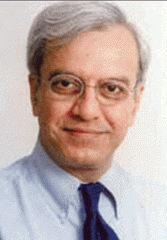Tradition of righteous reaction
 Rajiv Desai is president of Comma Consulting, Delhi
Rajiv Desai is president of Comma Consulting, Delhi
Through my pre-teen and teenage years, I spent a lot of time with my grandfather. He was a medical practitioner, theosophist, Congress party activist and a compassionate human being — my ideal.
One summer when my siblings and I were visiting his home in Surat, someone told him I had eaten meat. Grandfather wasn’t incensed or censorious; he simply said: “We don’t eat meat.” I was in awe of this man who attracted eminences like Rabindranath Tagore, Annie Besant, George Arundale, among others to his home. When he said something, I listened deferentially.
However, on this occasion, his comment rankled. Grandfather seemed to be suggesting that because of caste and religious strictures, our family was vegetarian. Having eaten a mutton samosa at a friend’s house, I thought to myself that his reaction was over the top. I knew he was tolerant and liberal; his extensive library included books by Bertrand Russell and other free thinkers. Thanks to him, we were spared the worst traditions of caste and religion.
The incident haunted me over the years. Since I admired him, I dismissed the episode as a one-off occurrence. Nevertheless, it came back to haunt me in the mid-1970s, when I was living in the US. Our high-profile India Forum in Chicago became a magnet for NGOs and activists of all types, looking at times for financial support but mostly to spread the gospel of the jholewala alternative. I termed it “the rise of righteous reaction”.
The ascent of righteous activists posing alternative, mostly woolly and impractical development models, was like a riptide generated by the Navnirman wave. Led by Jayaprakash Narayan, a Congress party dissenter, the movement was against the perceived corruption and, in a phrase cherished and propagated by the jholewala, ‘anti-people’ development policies of the Indira Gandhi government of the time.
Training his guns on prime minister Indira Gandhi, Narayan called for “total revolution,” a Maoist-style leap backward into anarchy which prompted the imposition of the Emergency in June 1975. Condemned worldwide as dictatorial regression, the Emergency destroyed the government’s credibility. The Congress Party was defeated in the general election of 1977.
However, even before the first non-Congress government assumed office in Delhi, things had begun to go awry. During what he thought was a revolutionary war, Narayan had called on the armed forces to revolt against the government. That’s when the steady erosion of his vastly inflated stature began, helped in no small measure by the subsequent fumbling and ineptitude of the Janata government which came to power in 1977.
Narayan’s movement had its roots in the margins of the Gandhian movement. The Mahatma’s success with the independence struggle allowed him to exhume and propagate an anti-Western, anti-modernity ideology drawn from his 1909 tract Hind Swaraj. Mohandas Gandhi challenged Jawaharlal Nehru’s modernisation agenda, recommending simplistic notions like village republics, self-sufficiency, nature cure and vegetarianism as national alternatives.
Like many students who studied in the US after him, Narayan became a Karl Marx admirer. However, when he returned to India he found his position pre-empted by Nehruvian economic policies that emphasised central planning and nationalisation of core industries. For him and his acolytes, it was a short step to the vituperative and impractical edicts of Hind Swaraj.
The Navnirman movement was confused at birth. it combined anti-Western and anti-modern strains of Gandhian utopianism and anti-market, anti-constitutional Marxist dogma. This weird and unsustainable campaign fell apart as casually as it was formed.
After the failure of Narayan’s movement, the role of righteous reaction became marginal. The protest against the Narmada Dam project led by a global coalition of NGOs gave it a second wind. Through the 1980s, the Indian jholewala brigade became involved with relatively benign campaigns against child labour, deforestation, and for employment generation, education, healthcare, etc.
In 2004, the newly-elected UPA government — recognising their contribution to social welfare and poverty alleviation — sought to co-opt the jholewala brigade into the National Advisory Council (NAC). The NAC’s deliberations focused on welfare and (citizens’) rights rather than the legitimacy of the government and political system. But a more virulent strain of jholewala activism surfaced with the appearance on the national stage of Anna Hazare and his disciples.
The Hazare protest went further than Narayan in challenging the legitimacy of the Constitution and the credibility of the political system. Sophisticated in the use of propaganda, the rural chieftain and his jholewala acolytes cleverly project their protest as being against corruption when actually it is a political assault on the UPA government and its leading party, the Congress. Like Narayan, Hazare over-reached himself and today, his protest has degenerated into a media relations effort.
Is the tradition of smug righteousness so deeply ingrained in the Indian psyche that it can only be contained, never eradicated? Who will be the next mahatma (with a small m)?
Also read: Priorities of BJP/NDA Government 2.0






 Rajiv Desai is president of Comma Consulting, Delhi
Rajiv Desai is president of Comma Consulting, Delhi










Add comment